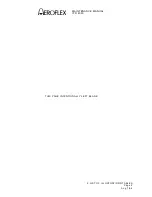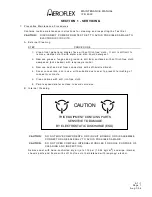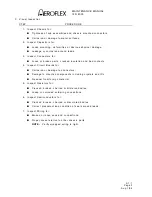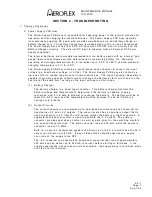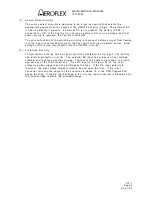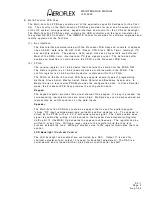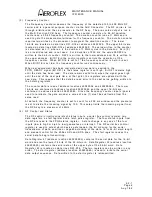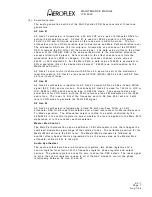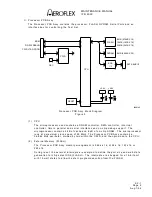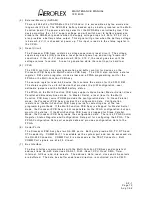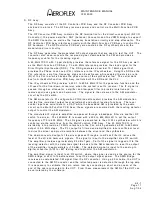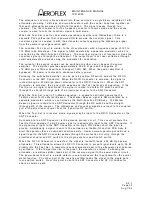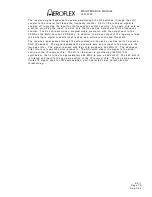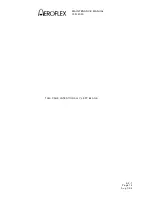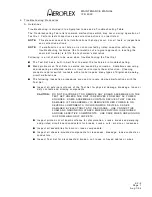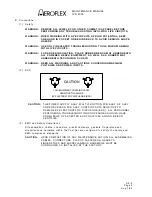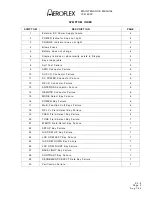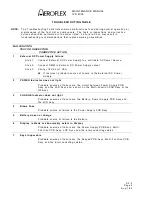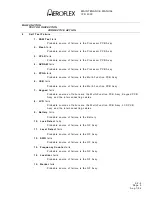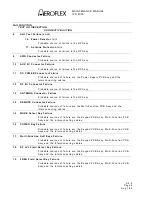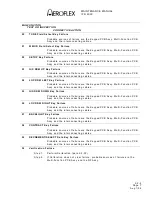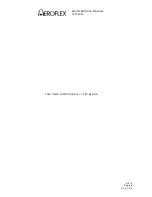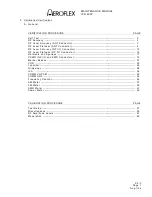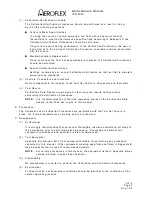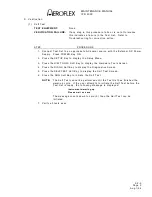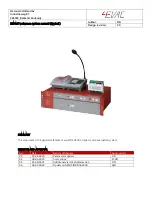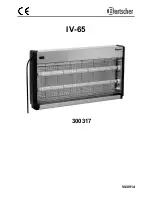
MAINTENANCE MANUAL
IFR 4000
2-2-1
Page 12
Aug 1/04
The attenuator circuitry is broken down into three sections: a single binary weighted 31 dB
attenuator providing 1 dB steps and two attenuators with the control lines tied together so
that each attenuator provides 30 dB of attenuation. The signal passes through two
couplers. The first coupler is for the frequency counter in receive mode and the second
coupler is used to sum the Localizer signal in dual mode.
When the Test Set is set for dual mode operation (Localizer and Glideslope), there is a
separate PLL synthesizer that is powered ON to provide the Localizer signal. This
Localizer signal is coupled in with the attenuator output supplying the Glideslope signal
from the normal signal generation path.
The Localizer PLL circuit is similar to the LO synthesizer with a frequency range of 107 to
118 MHz in 50 kHz steps. The signal is AM modulated by a separate modulator, which is
controlled by the Multi-Function PCB Assy. The Localizer signal is not leveled nor does the
Localizer signal go through the attenuator. The output level is not user settable although
small adjustments are made using the modulator for calibration.
The output of the second coupler can be switched to either use or bypass the power
amplifier. The amplifier provides approximately 30 dB of gain and is capable of
+16 dBm plus sufficient headroom to support 100% AM. When the power amplifier is
bypassed, DC power is removed to conserve battery power.
Following the switchable amplifier, an one pole 4 position RF switch selects the RF I/O
Connector or the ANT Connector. When the RFI/O Connector is selected, the signal is
routed through a 20 dB high power attenuator to the RFI/O Connector. When the ANT
Connector is selected, the signal path depends on the Test Set mode of operation. If the
Test Set is in single or dual mode, the signal is routed to another RF switch and then
through the straight-through path of a directional coupler to the ANT Connector.
When the Test Set is set in Tri-Mode operation, a separate oscillator generates the
75 MHz carrier for the Marker Beacon. The Marker Beacon signal is AM modulated by a
separate modulator, which is controlled by the Multi-Function PCB A ssy. The Marker
Beacon signal is routed to the ANT Connector through the RF switch and the straight-
through path of the coupler. The Glideslope and Localizer signals are input to the coupled
port of the directional coupler from the 4 position RF switch.
When the Test Set is in receive mode, signals may be input to the RFI/O Connector or the
ANT Connector.
Connected to the ANT Connector is the antenna protect circuit. This circuit protects the
Test Set from damage if a high power signal is inadvertently input to the ANT Connector. If
the signal level input to the ANT Connector is too high, PIN diodes short the input to
ground. Additionally a signal is sent to the software via the Multi-Function PCB A ssy to
alert the operator that an overload condition exists. Under normal operating conditions, a
signal input to the ANT Connector passes through the protection circuitry, through the
directional coupler and RF switch to the single pole four position RF switch.
When the RF I/O Connector is selected, the signal is routed through a 20 dB high power
attenuator. This attenuator allows the RF I/O Connector to accept signal levels up to 30 W
directly into the Test Set. A temperture sensor mounted next to the attenuator is monitored
by software. If the temperture rise is too great, the operator is alerted. Following the
attenuator a resistive splitter feeds part of the received signal to the power detect circuit.
The power detect circuit is a diode detector used to measure the input power for the power
meter function. The other port of the resistive splitter feeds the signal to the single pole
four-position switch. From this point on both the ANT Connector and RF I/O Connector
share a common path.
Summary of Contents for IFR 4000
Page 1: ...NAV COMM Test Set Maintenance Manual 1002 5600 4P0 IFR 4000...
Page 3: ...MAINTENANCE MANUAL IFR 4000 FOR QUALIFIED SERVICE PERSONNEL ONLY...
Page 4: ...MAINTENANCE MANUAL IFR 4000 THIS PAGE INTENTIONALLY LEFT BLANK...
Page 6: ...MAINTENANCE MANUAL IFR 4000 THIS PAGE INTENTIONALLY LEFT BLANK...
Page 12: ...MAINTENANCE MANUAL IFR 4000 INTRODUCTION Page 2 Aug 1 04 THIS PAGE INTENTIONALLY LEFT BLANK...
Page 32: ...MAINTENANCE MANUAL IFR 4000 2 2 1 Page 14 Aug 1 04 THIS PAGE INTENTIONALLY LEFT BLANK...
Page 34: ...MAINTENANCE MANUAL IFR 4000 2 2 1 Page 16 Aug 1 04 THIS PAGE INTENTIONALLY LEFT BLANK...
Page 42: ...MAINTENANCE MANUAL IFR 4000 2 2 2 Page 8 Aug 1 04 THIS PAGE INTENTIONALLY LEFT BLANK...
Page 108: ...MAINTENANCE MANUAL IFR 4000 2 2 4 Page 2 Aug 1 04 THIS PAGE INTENTIONALLY LEFT BLANK...
Page 160: ...MAINTENANCE MANUAL IFR 4000 2 2 4 Page 54 Aug 1 04 THIS PAGE INTENTIONALLY LEFT BLANK...
Page 166: ...MAINTENANCE MANUAL IFR 4000 2 3 1 Page 6 Aug 1 04 STEP PROCEDURE 4 Remove the Fuse...
Page 186: ...MAINTENANCE MANUAL IFR 4000 APPENDIX B Page 2 Aug 1 04 THIS PAGE INTENTIONALLY LEFT BLANK...
Page 188: ...MAINTENANCE MANUAL IFR 4000 APPENDIX C Page 2 Aug 1 04 THIS PAGE INTENTIONALLY LEFT BLANK...
Page 200: ...MAINTENANCE MANUAL IFR 4000 APPENDIX D Page 12 Aug 1 04 THIS PAGE INTENTIONALLY LEFT BLANK...
Page 206: ...MAINTENANCE MANUAL IFR 4000 APPENDIX E Page 6 Aug 1 04 THIS PAGE INTENTIONALLY LEFT BLANK...

